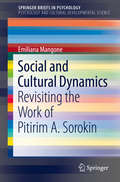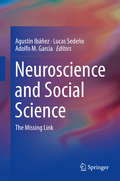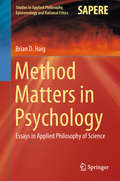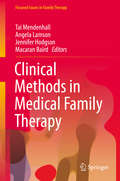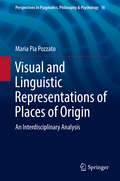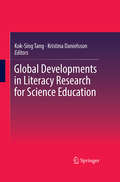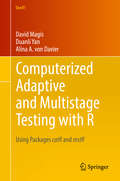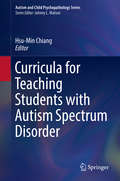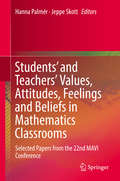- Table View
- List View
Social and Cultural Dynamics: Revisiting the Work of Pitirim A. Sorokin (SpringerBriefs in Psychology)
by Emiliana MangoneMarking the 50th anniversary of Pitirim A. Sorokin’s death, this Brief offers a critical analysis of the renowned sociologist’s theories while highlighting some of his more overlooked ones. Topics explored include cultural dynamics; the relationship between culture, society, and personality; social mobility; and the socio-cultural causality of time and space. In addition, this book updates these theories by discussing their relevance in current cultural contexts. The Brief aims to extend the work started by Sorokin on the promotion and application of “integralism”, an approach that conceives the change of any sociocultural phenomena as the result of the combination of external and internal forces. It uses this method to analyse socio-cultural phenomena, propose new policy, and enhance the development of humanity from the point of view of culture. This book also discusses sociology’s relationship with other sciences. In particular, it touches upon the interplay between sociology and psychology and pushes for a new scientific awareness that is transdisciplinary. The end point is a new vision of humanity and its development from a cultural context. Social and Cultural Dynamics will be of interest to social scientists, sociologists, and psychologists as well as professionals in these disciplines.
Research Advances in the Mathematical Education of Pre-service Elementary Teachers: An International Perspective (ICME-13 Monographs)
by Gabriel J. Stylianides Keiko HinoThis book examines new trends and developments in research related to the mathematical education of pre-service elementary teachers, and explores the implications of these research advances for theory and practice in teacher education. The book is organized around the following four overarching themes: pre-service teachers’ mathematics content and mathematics-specific pedagogical preparation; professional growth through activities and assessment tools used in mathematics teacher preparation programs; pre-service mathematics teachers’ knowledge and beliefs; and perspectives on noticing in the preparation of elementary mathematics teachers. Including contributions from researchers working in 11 different countries, the book offers a forum for discussing and debating the state of the art regarding the mathematical preparation of pre-service elementary teachers. By presenting and discussing the findings of research conducted in different countries, the book offers also opportunities to readers to learn about varying teacher education practices around the world, such as: innovative practices in advancing or assessing teachers’ knowledge and beliefs, similarities and differences in the formal mathematics education of teachers, types of and routes in teacher education, and factors that can influence similarities or differences.
Teaching and Learning Algebraic Thinking with 5- to 12-Year-Olds: The Global Evolution of an Emerging Field of Research and Practice (ICME-13 Monographs)
by Carolyn KieranThis book highlights new developments in the teaching and learning of algebraic thinking with 5- to 12-year-olds. Based on empirical findings gathered in several countries on five continents, it provides a wealth of best practices for teaching early algebra. Building on the work of the ICME-13 (International Congress on Mathematical Education) Topic Study Group 10 on Early Algebra, well-known authors such as Luis Radford, John Mason, Maria Blanton, Deborah Schifter, and Max Stephens, as well as younger scholars from Asia, Europe, South Africa, the Americas, Australia and New Zealand, present novel theoretical perspectives and their latest findings. The book is divided into three parts that focus on (i) epistemological/mathematical aspects of algebraic thinking, (ii) learning, and (iii) teaching and teacher development. Some of the main threads running through the book are the various ways in which structures can express themselves in children’s developing algebraic thinking, the roles of generalization and natural language, and the emergence of symbolism. Presenting vital new data from international contexts, the book provides additional support for the position that essential ways of thinking algebraically need to be intentionally fostered in instruction from the earliest grades.
Well-Being of Youth and Emerging Adults across Cultures: Novel Approaches and Findings from Europe, Asia, Africa and America (Cross-Cultural Advancements in Positive Psychology #12)
by Radosveta DimitrovaThe current volume presents new empirical data on well-being of youth and emerging adults from a global international perspective. Its outstanding features are the focus on vast geographical regions (e.g., Europe, Asia, Africa, North and South America), and on strengths and resources for optimal well-being. The international and multidisciplinary contributions address the complexities of young people’s life in a variety of cultural settings to explore how key developmental processes such as identity, religiosity and optimism, social networks, and social interaction in families and society at large promote optimal and successful adaptation. The volume draws on core theoretical models of human development to highlight the applicability of these frameworks to culturally diverse youth and emerging adults as well as universalities and cultural specifics in optimal outcomes. With its innovative and cutting-edge approaches to cultural, theoretical and methodological issues, the book offers up-to-date evidence and insights for researchers, practitioners and policy makers in the fields of cross-cultural psychology, developmental science, human development, sociology, and social work.
Neuroscience and Social Science: The Missing Link
by Agustín Ibáñez Lucas Sedeño Adolfo M. GarcíaThis book seeks to build bridges between neuroscience and social science empirical researchers and theorists working around the world, integrating perspectives from both fields, separating real from spurious divides between them and delineating new challenges for future investigation. Since its inception in the early 2000s, multilevel social neuroscience has dramatically reshaped our understanding of the affective and cultural dimensions of neurocognition. Thanks to its explanatory pluralism, this field has moved beyond long standing dichotomies and reductionisms, offering a neurobiological perspective on topics classically monopolized by non-scientific traditions, such as consciousness, subjectivity, and intersubjectivity. Moreover, it has forged new paths for dialogue with disciplines which directly address societal dynamics, such as economics, law, education, public policy making and sociology. At the same time, beyond internal changes in the field of neuroscience, new problems emerge in the dialogue with other disciplines.Neuroscience and Social Science – The Missing Link puts together contributions by experts interested in the convergences, divergences, and controversies across these fields. The volume presents empirical studies on the interplay between relevant levels of inquiry (neural, psychological, social), chapters rooted in specific scholarly traditions (neuroscience, sociology, philosophy of science, public policy making), as well as proposals of new theoretical foundations to enhance the rapprochement in question.By putting neuroscientists and social scientists face to face, the book promotes new reflections on this much needed marriage while opening opportunities for social neuroscience to plunge from the laboratory into the core of social life. This transdisciplinary approach makes Neuroscience and Social Science – The Missing Link an important resource for students, teachers, and researchers interested in the social dimension of human mind working in different fields, such as social neuroscience, social sciences, cognitive science, psychology, behavioral science, linguistics, and philosophy.
Supervision of Family Therapy and Systemic Practice (Focused Issues in Family Therapy)
by Arlene Vetere Jim SheehanThis much-needed volume examines the process and practice of supervision in family therapy, with special emphasis on systemic practice. Expert trainers and supervisors from diverse disciplines take a systemic tour of the relationships between supervisor, therapist, and client, analyzing the core skills of effective, meaningful supervision—including questioning, listening, and reflecting—and their impact on therapy. These skills and others are applied to supervising therapy with individuals, couples, and families in areas including substance abuse, domestic violence, and research settings. Throughout the book, contributors share self-care strategies, so supervisors can stay engaged and creative, meet the many challenges entailed in their work, and avoid burnout.Among the topics covered:The resonance from personal life in family therapy supervision.Creating a dialogical culture for supervision.The supervisor’s power and moments of learning.Supervision and domestic violence: therapy with individuals, couples, and families.Systemic supervision with groups in child protection contexts.When the supervision process falters and breaks down: pathways to repair. The highly practical information in Supervision of Family Therapy and Systemic Practice is adaptable by readers to their particular supervisory or training needs. Novice and veteran mental health, social care, and social work practitioners and psychotherapists, will find it a substantial resource.
Method Matters in Psychology: Essays in Applied Philosophy of Science (Studies in Applied Philosophy, Epistemology and Rational Ethics #45)
by Brian D. HaigThis book applies a range of ideas about scientific discovery found in contemporary philosophy of science to psychology and related behavioral sciences. In doing so, it aims to advance our understanding of a host of important methodological ideas as they apply to those sciences. A philosophy of local scientific realism is adopted in favor of traditional accounts that are thought to apply to all sciences. As part of this philosophy, the implications of a commitment to philosophical naturalism are spelt out, and a correspondence theory of truth is defended by showing how it helps explain various features of scientific practice. The central chapter of the book presents a broad theory of scientific method that comprises the detection of empirical phenomena and their subsequent understanding by constructing explanatory theories through the use of abductive methods. This theory of scientific method is then used as a framework to reconstruct the well-known qualitative method of grounded theory, and to present a systematic perspective on clinical reasoning and case formulation. Relatedly, an abductive or explanationist understanding of methods is employed to evaluate the knowledge credentials of evolutionary psychology. In addition, the conceptual and methodological foundations of a variety of quantitative methods are examined. Exploratory factor analysis and tests of statistical significance are given special attention.
Deep Experiencing: Dialogues Within the Self (SpringerBriefs in Psychology)
by Olga V. Lehmann Jaan ValsinerThis Brief brings together empirical accounts that contribute to the investigation of the cultural phenomena of deep personal experiences. It examines everyday life experiences and its influence on the development of successful social interactions. Issues of silence, the subjective feelings of opportunities, and culturally canalized feelings of “being here” or “being influenced by others" are all deep personal experiences that are rooted within the framework of cultural psychology. By bringing together the discourses of Dialogical Self Theory (DST) and Cultural Psychology of Semiotic Mediation for a new generation of researchers who address issues of this phenomenon, chapters aim to link phenomena-saturated empirical accounts with general theoretical innovations. In addition, the Brief studies socially relevant issues from the lenses of Cultural Psychology. Topics featured in this Brief include: Globalization and its effect on identity and personal experiences. The subjective nature of opportunities. Migrating identities across generations. Serious illness and its influence on communication. Deep Experiencing will be of interest to researchers, professors, and graduate students in the fields of psychology, cognitive psychology, medicine, anthropology, social work, and aesthetics.
Test of Implicit Associations in Relationship Attitudes: Manual for a New Method (SpringerBriefs in Psychology)
by Victor Karandashev Nicholas D. EvansThis volume presents a manual for a new method of studying implicit attitudes, the Test of Implicit Associations in Relationship Attitudes (TIARA). The main goal of this volume is to demonstrate how to study the implicit attitudes that people have toward others in their close relationships: friend, romantic partner, family member, etc. Since the inception of the concept and measures of implicit cognition, researchers have developed a number of indirect measures to assess implicit attitudes. These similar yet different methods aim to account for different variables for reliable and valid operational definitions of implicit attitudes. Given the progress made in the field of implicit measures, there is great potential for further development and extension of these types of assessments. Many of these methods (especially the Implicit Attitude Test) are only limited to assessing attitudes within the comparison of two bipolar concepts. Therefore, TIARA was developed to be a manual for a new method of studying implicit attitudes in relationships. As described in this volume, TIARA shows that if a person strongly believes that certain feelings can be attributed to a target relationship figure, the reaction time is shorter since they are the most confident in their answer. Beginning with a grounded explanation of the theory behind TIARA, the volume then proceeds to explain its methods and procedures, and how to code, score, and interpret the results of TIARA. Next, the volume reports on six psychometric studies, which provide substantial evidence that TIARA is a valid and reliable measure to study implicit attitudes in relationship research. The volume concludes by exploring practical applications of TIARA as well as its future directions and current limitations. The detailed description of the TIARA method provides a practical and handy tutorial for using the method in research and practice for social and personality psychologists, as well as practitioners.
Clinical Methods in Medical Family Therapy (Focused Issues in Family Therapy)
by Tai Mendenhall Angela Lamson Jennifer Hodgson Macaran BairdThis landmark text describes research-informed practices and applications of Medical Family Therapy (MedFT) across a range of care environments and clinical populations (e.g., family medicine, obstetrics and gynecology, psychiatry, alcohol and drug treatment, community health centers, and military and veteran health systems). It is a timely release for a rapidly growing field. It includes the work of some of MedFT’s most innovative leaders, who expertly: illustrate MedFT in action across primary, secondary, tertiary, and other unique health contextsdescribe the make-up of healthcare teams tailored to each chapter’s distinct environment(s)highlight fundamental knowledge and critical skillsets across diverse healthcare contextsdetail research-informed practices for MedFTs who treat patients, couples, families, and communities Clinical Methods in Medical Family Therapy is a comprehensive source for any behavioral health student, trainee, or professional looking to understand the necessary skills for MedFTs entering the healthcare workforce. It is also an essential read for trainers and instructors who are covering the fundamental MedFT knowledge and skills across diverse healthcare contexts. This text was written to be applicable for a wide variety of healthcare disciplines, including family therapy, counseling nursing, medicine, psychology and social work.
Visual and Linguistic Representations of Places of Origin: An Interdisciplinary Analysis (Perspectives in Pragmatics, Philosophy & Psychology #16)
by Maria Pia Pozzato Alessandra Bonazzi Enzo D'Armenio Paola Donatiello Emanuele Frixa Giulia Mazzeo Federico Montanari Margherita Murgiano Giulia NardelliThis book is about the representations - both visual and linguistic - which people give of their own places of origin. It examines the drawings of interviewees who were asked to draw their own place of origin on a white A3 sheet, using pencil or colour, according to their choice. If they were born in a place they did not remember because they moved in when they were very small, they could draw the place they did remember as the scenario of their early childhood. The drawings are examined from three different perspectives: semiotics, cognitive psychology and geography. The semiotic instruments are used to describe how each person reconstructs a complex image of his/her childhood place, and how they translate their own memories from one language to another, e.g. from drawing to verbal story, trying to approach what they want to express in the best possible way. The cognitive-psychological point of view helps clarify the emotional world of the interviewees and their motivations during the process of reconstruction and expression of their childhood experiences. The geographical conceptualizations concern a cultural level and provide insight into the cartographic models that inspire the maps people drew. One of the main findings was the influence from cultural codes as demonstrated in the fact that most of the US students interviewed drew their maps showing considerable cartographic expertise in comparison to their European counterparts.
Promoting Safe and Effective Transitions to College for Youth with Mental Health Conditions: A Case-Based Guide to Best Practices
by Adele Martel Jennifer Derenne Patricia K. LeebensThis concise and practical book provides an overview of how to safely and effectively transition adolescents with mental health conditions into a college environment. Therapeutic strategies to assess and promote readiness for transition to college are discussed in case-based chapters, which include case history, analysis of transition, clinical pearls, literature review, and helpful resources for clinicians, patients, and families. Filling a significant gap in the literature, Promoting Safe and Effective Transitions to College for Youth with Mental Health Conditions: A Case-Based Guide to Best Practices delivers essential information for psychiatrists, psychologists, and other mental health professionals who work with children, adolescents, and their families before, during, and after the transition to college.
A Battle Plan for Supporting Military Families: Lessons for the Leaders of Tomorrow (Risk and Resilience in Military and Veteran Families)
by Linda Hughes-Kirchubel Shelley MacDermid Wadsworth David S. RiggsThis unique reference integrates knowledge culled from fifteen years of U.S. deployments to create an action plan for supporting military and veteran families during future conflicts. Its innovative ideas stretch beyond designated governmental agencies (e.g., Department of Defense, VA) to include participation from, and possible collaborations with, the business/corporate, academic, advocacy, and philanthropic sectors. Contributors identify ongoing and emerging issues affecting military and veteran families and recommend specific strategies toward expanding and enhancing current programs and policy. This proactive agenda also outlines new directions for mobilizing the research community, featuring strategies for addressing institutional challenges and improving access to critical data.Included in the coverage: Lessons learned inside the Pentagon.Merging reintegration streams for veterans and military families.The unique role of professional associations in assisting military families: a case study. Philanthropy for military and veteran families: challenges past, recommendations for tomorrow.Rules of engagement: media coverage of military families during war. Designing and implementing strategic research studies to support military families.A Battle Plan for Supporting Military Families is of immediate usefulness to leaders, professionals, and future professionals in interdisciplinary academic, governmental, advocacy, and philanthropic areas of focus interested in the theoretical, practical, and real-life concerns and needs of military-affiliated families.
Prospective Memory: Remembering to Remember, Remembering to Forget (SpringerBriefs in Psychology)
by Anna-Lisa Cohen Jason L. HicksThis Brief offers a comprehensive and up-to-date overview of the current developments in the field of prospective memory, or memory for delayed intentions. It explores several key areas in prospective memory research, including computational modeling, neuroscience and prospective memory, output monitoring, and implementation intentions. It seeks to increase understanding of prospective memory as well as offer the latest and most compelling findings in the field. Prospective memory, or the act of remembering to carry out a previously formed intention, requires the processes of encoding, storage, and delayed retrieval of intended actions. Chapters in this Brief discuss the implementation and execution of intended actions, as well as the conditions in which they can fail. In addition, chapters also include reviews of the current state of the neuroscience of prospective memory as well as developments in statistical modeling. Laboratory research in the field of prospective memory began in the late 1980s and since then, the number of studies has increased exponentially. This Brief provides timely and relevant information in a field that is ever expanding and growing. This Brief is an informative resource for researchers and undergraduate and graduate students in the field of psychology, cognitive psychology, and neuroscience.
Escalation of Commitment in Internationalization Processes: The Role of Bounded Rationality in the Uppsala Model (MIR Series in International Business)
by Björn RöberThis unique book on international business presents a critical review of the role of bounded rationality in internationalization process (IP) research. Corporate internationalization processes have been a subject of scientific debate for several decades. However, it is questionable whether behavioral research insights are sufficiently acknowledged in this academic discipline. Against this backdrop, the author critically assesses the behavioral assumptions of the Uppsala Model, which is commonly considered to be the pivotal approach in internationalization process research.
Global Developments in Literacy Research for Science Education
by Kok-Sing Tang Kristina DanielssonThis book highlights recent developments in literacy research in science teaching and learning from countries such as Australia, Brazil, China, Finland, Germany, Hong Kong, New Zealand, Norway, Singapore, Spain, South Africa, Sweden, Taiwan, and the United States. It includes multiple topics and perspectives on the role of literacy in enhancing science teaching and learning, such as the struggles faced by students in science literacy learning, case studies and evaluations of classroom-based interventions, and the challenges encountered in the science classrooms. It offers a critical and comprehensive investigation on numerous emerging themes in the area of literacy and science education, including disciplinary literacy, scientific literacy, classroom discourse, multimodality, language and representations of science, and content and language integrated learning (CLIL). The diversity of views and research contexts in this volume presents a useful introductory handbook for academics, researchers, and graduate students working in this specialized niche area. With a wealth of instructional ideas and innovations, it is also highly relevant for teachers and teacher educators seeking to improve science teaching and learning through the use of literacy.
Redefining Management: Smart Power Perspectives
by Varda Muhlbauer Wes HarryThis progressive -volume introduces the concept of smart power in management, bringing contemporary humanistic values to the power dynamics of organizations and businesses. The chapters review sociopolitical, economic, and technological conditions fueling the recent shift in ideas about power in management, from the globalization of business to young workers’ motivation regarding their jobs and careers. Contributors examine a range of models, processes, and frameworks for planning and implementing smart power across diverse organizations, with accompanying challenges and caveats. In its theory and examples, the book makes a cogent case for the shift from traditional hard power, with its winner takes all culture and potential for abuses, to a more creative and democratic model. Included in the coverage: · The power of change and the need to change power: changing perception of power in the organizational setting. · The dynamics of Information and Communication Technologies and smart power: implications for managerial practice.· Economic growth, management, and smart power.· New Ways of Working: from smart to shared power.· Positive psychological capital: from strengths to power.· Narcissistic leadership in organizations: a two-edged sword. Redefining management : Smart power perspectives is proactive reading for students in professional and business-related academic fields (e.g., organizational behavior, sociology, and business and management), and for managers at all organizational levels. The book is a harbinger of transformative possibilities shaping the management landscape to come.
Computerized Adaptive and Multistage Testing with R: Using Packages catR and mstR (Use R!)
by David Magis Duanli Yan Alina A. von DavierThe goal of this guide and manual is to provide a practical and brief overview of the theory on computerized adaptive testing (CAT) and multistage testing (MST) and to illustrate the methodologies and applications using R open source language and several data examples. Implementation relies on the R packages catR and mstR that have been already or are being developed by the first author (with the team) and that include some of the newest research algorithms on the topic. The book covers many topics along with the R-code: the basics of R, theoretical overview of CAT and MST, CAT designs, CAT assembly methodologies, CAT simulations, catR package, CAT applications, MST designs, IRT-based MST methodologies, tree-based MST methodologies, mstR package, and MST applications. CAT has been used in many large-scale assessments over recent decades, and MST has become very popular in recent years. R open source language also has become one of the most useful tools for applications in almost all fields, including business and education. Though very useful and popular, R is a difficult language to learn, with a steep learning curve. Given the obvious need for but with the complex implementation of CAT and MST, it is very difficult for users to simulate or implement CAT and MST. Until this manual, there has been no book for users to design and use CAT and MST easily and without expense; i.e., by using the free R software. All examples and illustrations are generated using predefined scripts in R language, available for free download from the book's website.
A Psychology of Culture (International and Cultural Psychology)
by Michael B. SalzmanThis thought-provoking treatise explores the essential functions that culture fulfills in human life in response to core psychological, physiological, and existential needs. It synthesizes diverse strands of empirical and theoretical knowledge to trace the development of culture as a source of morality, self-esteem, identity, and meaning as well as a driver of domination and upheaval. Extended examples from past and ongoing hostilities also spotlight the resilience of culture in the aftermath of disruption and trauma, and the possibility of reconciliation between conflicting cultures. The stimulating insights included here have far-reaching implications for psychology, education, intergroup relations, politics, and social policy. Included in the coverage: · Culture as shared meanings and interpretations. · Culture as an ontological prescription of how to “be” and “how to live.” · Cultural worldviews as immortality ideologies. · Culture and the need for a “world of meaning in which to act.”· Cultural trauma and indigenous people.· Constructing situations that optimize the potential for positive intercultural interaction.· Anxiety and the Human Condition.· Anxiety and Self Esteem.· Culture and Human Needs. A Psychology of Culture takes an uncommon tour of the human condition of interest to clinicians, educators, and practitioners, students of culture and its role and effects in human life, and students in nursing, medicine, anthropology, social work, family studies, sociology, counseling, and psychology. It is especially suitable as a graduate text.
Legal Signs Fascinate: Kevelson's Research on Semiotics (SpringerBriefs in Law)
by Jan M. Broekman Frank FleerackersThis engaging book examines the origins and first effects of the concept ‘legal semiotics’, focusing on the inventor of the term, Roberta Kevelson (1931-1998). It highlights the importance of her ideas and works which have contributed to legal theory, legal interpretation and philosophy of language. Kevelson’s work is particularly relevant today, in our world of global electronic communication networks which rely so much on language, signs, signals and shortcuts. Kevelson could not have foreseen the 21st century, yet the story of her work and influence deserves more attention as it is key to our understanding of modern legal discourse and why law fascinates and is accepted in modern society. The authors draw on Kevelson’s hitherto unknown Office Papers and Notes, and a biographical examination points to key influences in her work such as the early feminist movements of the US East Coast, the philosophy of Charles Sanders Peirce and the semiotics of Thomas Sebeok. This forms the basis for a more encompassing research of Kevelson’s position, work and philosophical background, which the authors call for. A quick and enlightening read, this book interests a wide range of readers with an interest in legal history and the fields which Kevelson both drew on and influenced, including lawyers, students and scholars.
Technology and Adolescent Mental Health
by Megan A. Moreno Ana RadovicThis comprehensive book provides a framework for healthcare providers working with the dual challenges and opportunities presented by the intersection of mental health and technology. Technology and Adolescent Mental Health provides recent, evidence-based approaches that are applicable to clinical practice and adolescent care, with each chapter including a patient case illustrating key components of the chapter contents. Early chapters address the epidemiology of mental health, while the second section of the book deals with how both offline and online worlds affect mental health, presenting both positive and negative outcomes, and focusing on special populations of at-risk adolescents. The third section of the book focuses on technology uses for observation, diagnosis or screening for mental health conditions. The final section highlights promising future approaches to technology, and tools for improving intervention and treatment for mental health concerns and illnesses. This book will be a key resource for pediatricians, family physicians, internal medicine providers, adolescent medicine and psychiatry specialists, psychologists, social workers, as well as any other healthcare providers working with adolescents and mental health care.
Educational Technology and Narrative: Story and Instructional Design
by Brad Hokanson Gregory Clinton Karen KaminskiThis volume is the result of a 2016 research symposium sponsored by the Association for Educational Communications and Technology (AECT) focused on the growing theoretical areas of integrating story and narrative into educational design. Narrative, or storytelling, is often used as a means for understanding, conveying, and remembering the events of our lives. Our lives become a series of stories as we use narrative to structure our thinking; stories that teach, train, socialize, and create value. The contributions in this volume examine stories and narrative in instructional design and offer a diverse exploration of instructional design and learning environments.Among the topics discussed:The narrative imperative: creating a story telling culture in the classroom.Narrative qualities of design argumentation.Scenario-based workplace training as storytelling.Designing for adult learners' metacognitive development & narrative identity.Using activity theory in designing science inquiry games .Changing the narrative of school: toward a neurocognitive redefinition of learning. Educational Technology and Narrative is an invaluable resource offering application-ready ideas to students of instructional design, instructional design practitioners, and teachers seeking to utilize theories of story and narrative to the ways that they convey and express ideas of instructional design and educational technology.
More Harm than Good?: The Moral Maze of Complementary and Alternative Medicine
by Edzard Ernst Kevin SmithThis book reveals the numerous ways in which moral, ethical and legal principles are being violated by those who provide, recommend or sell ‘complementary and alternative medicine’ (CAM). The book analyses both academic literature and internet sources that promote CAM. Additionally the book presents a number of brief scenarios, both hypothetical and real-life, about individuals who use CAM or who fall prey to ethically dubious CAM practitioners. The events and conundrums described in these scenarios could happen to almost anyone. Professor emeritus of complementary medicine Edzard Ernst together with bioethicist Kevin Smith provide a thorough and authoritative ethical analysis of a range of CAM modalities, including acupuncture, chiropractic, herbalism, and homeopathy. This book could and should interest all medical professionals who have contact to complementary medicine and will be an invaluable reference for patients deliberating which course of treatment to adopt.
Curricula for Teaching Students with Autism Spectrum Disorder (Autism and Child Psychopathology Series)
by Hsu-Min ChiangThis book provides an extensive overview of curricula and instructional strategies for teaching children with autism spectrum disorder (ASD). It offers an empirically solid framework for designing and developing interventions for learners along the autism spectrum by reducing skill deficits and enhancing learner strengths while being flexible enough to allow for individual differences. The book discusses key concepts in educating individuals with ASD as they impact the processes of syllabus building, from planning goals and objectives to generating content choosing appropriate teaching strategies, and assessing progress. Chapters detail curriculum designs in academic areas such as language skills, science, and social studies, as well as functional skills, including independent living, career development, and preventing social victimization. The book concludes with recommendations for future interventions and curricula-building. Among the topics covered:Communication and autism spectrum disorder.Mathematical problem-solving instruction for students with ASD.Visual arts curriculum for students with ASD.How to build programs focused on daily living and adult independence.Sexuality education for students with ASD. Curricula for Teaching Students with Autism Spectrum Disorder is a must-have resource for researchers, graduate students, and clinicians and related therapists and professionals in clinical child and school psychology, childhood/special education, social work, developmental psychology, behavioral therapy/rehabilitation, and child and adolescent psychiatry.
Students' and Teachers' Values, Attitudes, Feelings and Beliefs in Mathematics Classrooms: Selected Papers from the 22nd MAVI Conference
by Hanna Palmér Jeppe SkottThis contributed volume is an exciting product of the 22nd MAVI conference, which presents cutting-edge research on affective issues in teaching and learning math. The teaching and learning of mathematics is highly dependent on students’ and teachers’ values, attitudes, feelings, beliefs and motivations towards mathematics and mathematics education. These peer-reviewed contributions provide critical insights through their theoretically and methodologically diverse analyses of relevant issues related to affective factors in teaching and learning math and offer new tools and strategies by which to evaluate affective factors in students’ and teachers’ mathematical activities in the classroom. Among the topics discussed: The relationship between proxies for learning and mathematically related beliefs.Teaching for entrepreneurial and mathematical competences.Prospective teachers’ conceptions of the concepts mean, median, and mode.Prospective teachers’ approach to reasoning and proofThe impact of assessment on students’ experiences of mathematics. Through its thematic connections to teacher education, professional development, assessment, entrepreneurial competences, and reasoning and proof, Students' and Teachers' Values, Attitudes, Feelings and Beliefs in Mathematics Classrooms proves to be a valuable resource for educators, practitioners, and students for applications at primary, secondary, and university levels.
